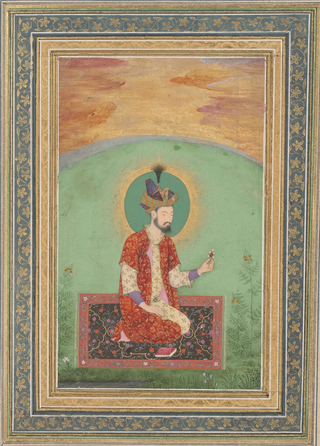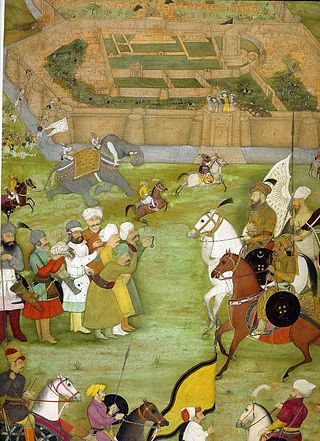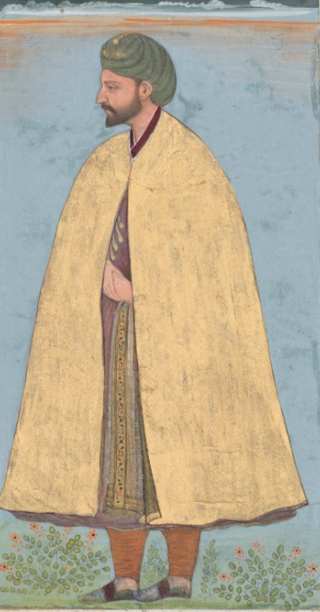
Bayezid II was the sultan of the Ottoman Empire from 1481 to 1512. During his reign, Bayezid consolidated the Ottoman Empire, thwarted a Safavid rebellion and finally abdicated his throne to his son, Selim I. Bayezid evacuated Sephardi Jews from Spain following the fall of the Nasrid Kingdom of Granada and the proclamation of the Alhambra Decree and resettled them throughout Ottoman lands, especially in Salonica.

Babur, born Zahīr ud-Dīn Muhammad, was the founder of the Mughal Empire in the Indian subcontinent. He was a descendant of Timur and Genghis Khan through his father and mother respectively. He was also given the posthumous name of Firdaws Makani.

Mirza Nasir al-Din Muhammad, commonly known by his regnal name Humayun, was the second Mughal emperor, who ruled over territory in what is now Eastern Afghanistan, Bangladesh, Northern India, and Pakistan from 1530 to 1540 and again from 1555 to his death 1556. At the time of his passing, the Mughal Empire spanned almost one million square kilometres.

The 16th century began with the Julian year 1501 and ended with either the Julian or the Gregorian year 1600 (MDC), depending on the reckoning used.

The Mughal emperors were the supreme rulers of the Mughal Empire in the Indian subcontinent, mainly corresponding to the modern countries of India, Pakistan, Afghanistan and Bangladesh. They ruled parts of India from 1526, and by 1707, ruled most of the subcontinent. Afterwards, they declined rapidly, but nominally ruled territories until the 1857 rebellion.
Bayezid, an Arabic, Persian, and Turkish name, from the Arabic بايزيد, meaning "a devoted saint", may refer to:

The Akbarnama, is the official chronicle of the reign of Akbar, the third Mughal Emperor, commissioned by Akbar himself and written by his court historian and biographer, Abu'l-Fazl ibn Mubarak. It was written in Persian, which was the literary language of the Mughals, and includes vivid and detailed descriptions of his life and times. It followed the Baburnama, the more personal memoir by his grandfather, Babur, founder of the dynasty. It was produced in the form of lavishly illustrated manuscripts.

Muhammad Bairam Khan, commonly known as Bairam Khan or Bayram Khan was an important military commander, and later commander-in-chief of the Mughal army, a powerful statesman and regent at the court of the Mughal Emperors, Humayun and Akbar. He was also the guardian, chief mentor, adviser, teacher and the most trusted ally of Akbar. Akbar honoured him as Khan-i-Khanan, which means "King of Kings". Bairam was originally called Bairam "Beg", but later became honoured as Khan. Bairam Khan was an aggressive general who was determined to restore Mughal authority in India.

Khanzada Mirza Khan Abdul Rahim, popularly known as simply Rahim and titled Khan-i-Khanan, was a poet who lived in India during the rule of Mughal emperor Akbar, who was Rahim's mentor. He was one of the nine important ministers (dewan) in Akbar's court, known as the Navaratnas. Rahim was known for his Hindustani dohe (couplets) and his books on astrology.

Gulbadan Begum was a Mughal princess and the daughter of Emperor Babur, the founder of the Mughal Empire.

The Medici giraffe was a giraffe presented to Lorenzo de' Medici on November 18, 1487, by al-Ashraf Qaitbay, the Burji Mamluk Sultan of Egypt, in an attempt to win the support of the Medici.

Abu'l-Fath Jalal-ud-din Muhammad Akbar, popularly known as Akbar the Great, and also as Akbar I, was the third Mughal emperor, who reigned from 1556 to 1605. Akbar succeeded his father, Humayun, under a regent, Bairam Khan, who helped the young emperor expand and consolidate Mughal domains in the Indian subcontinent.
Begum is a female title which is also used in Mirza families/lineages, Daughter of Beg or Wife of Beg, a given name and surname.
Ruqaiya Sultan Begum was the first and chief wife of the third Mughal emperor, Akbar.

Salima Sultan Begum was the third wife and one of the chief consorts of the Mughal emperor Akbar, and the granddaughter of Babur.
Bega Begum was Empress consort of the Mughal Empire from 26 December 1530 to 17 May 1540 and 22 February 1555 to 27 January 1556 as the first wife and chief consort of the second Mughal emperor Humayun. She was known as Zan-i-Kalan being the first wife of Humayun and was also known as Haji Begum after she performed the Hajj pilgrimage.

Khanzada Begum was a Timurid princess and the eldest daughter of Umar Shaikh Mirza II, the amir of Ferghana. She was also the elder sister of Babur, the founder of the Mughal Empire. She and her brother remained deeply attached to each other all their lives, a period during which the family progressed from ruling a tiny and obscure principality in Central Asia to ruling a large portion of the Indian subcontinent. Babur conferred on his sister, the honorable title of Padshah Begum and she was really the first lady of his Empire after his death.

Gevherhan Hatun was an Ottoman princess, the daughter of Mehmed the Conqueror and Gülbahar Hatun. She was the sister of Sultan Bayezid II.

The foreign relations of the Mughal Empire were characterized by competition with the Persian Empire to the west, the Marathas and others to the south, and the British to the east. Steps were taken by successive Mughal rulers to secure the western frontiers of India. The Khyber Pass along the Kabul- Qandhar route was the natural defence for India, and their foreign policy revolved around securing these outposts, as also balancing the rise of powerful empires in the region. During the break up of the Timurid Empire in the 15th century, the Ottomans in Turkey, the Safavids in Persia and the Uzbegs in central Asia emerged as the new contenders of power. While the Safavids were Shia by faith, Ottomans along with Uzbegs were Sunni. The Mughals were also Sunni and Uzbegs were their natural enemies, who caused Babur and other Timurid princes to leave Khurasan and Samarqand. The powerful Uzbegs who held sway over central India sought an alliance of Sunni powers to defeat the Shia ruled Persia, but Mughals were too broadminded to be driven away by the sectarian conflicts. The Mughal rulers, especially Akbar, were keen to develop strong ties with Persia in order to balance the warring Uzbegs. Thus, the foreign policy of Mughals was centred around strengthening the ties with Persia, while maintaining the balance of power in the region by keeping a check on the evolution of a united Uzbeg empire.

Najib al-Din Humayun, commonly known as Hakim Humam or Hakim Hamam, was a physician (hakim) and an official in the service of the Mughal emperor Akbar. A native of Gilan in present-day Iran, he migrated to present-day India with his brothers because of Safavid persecution. He held several positions in Akbar's service, and served as the Mughal ambassador to Abdullah Khan II of Bukhara.
















